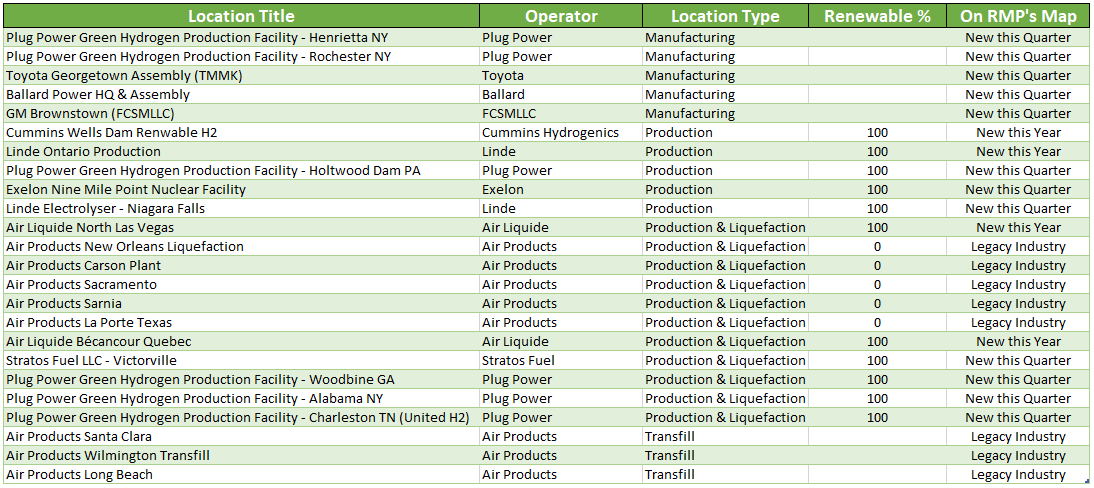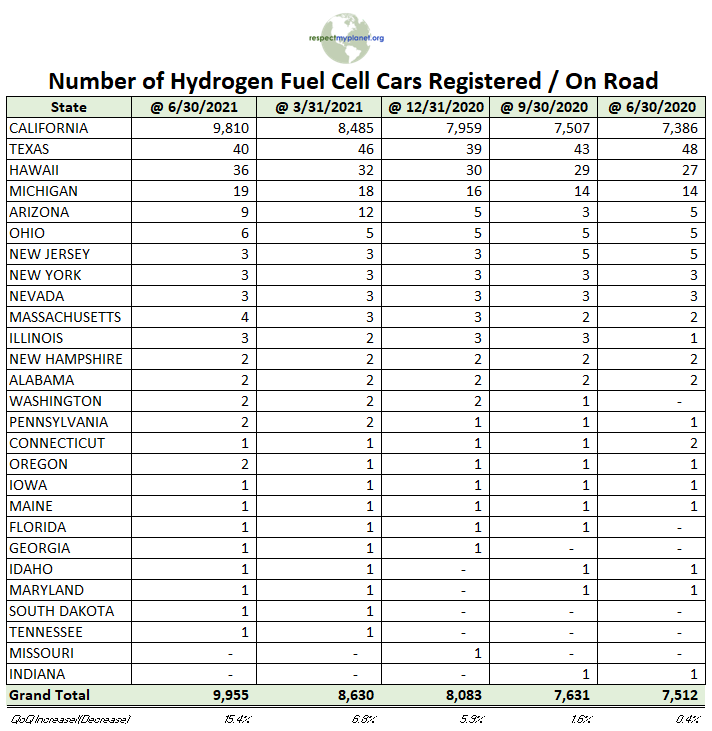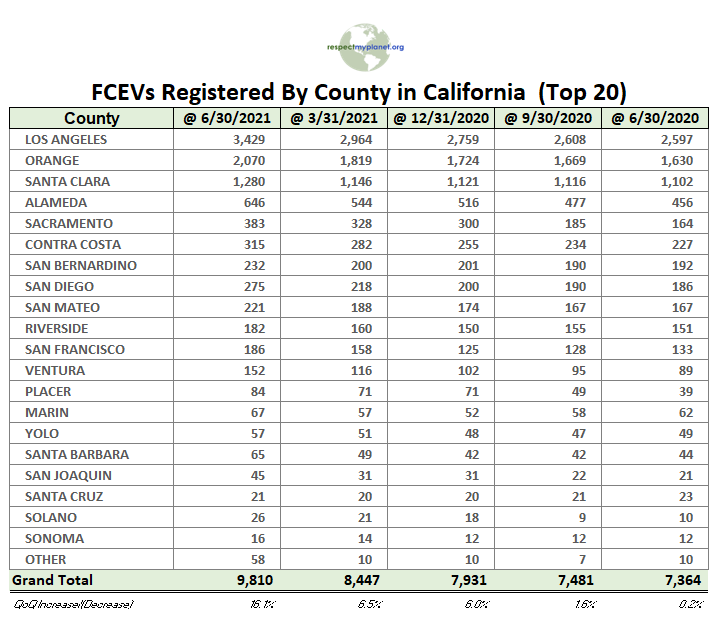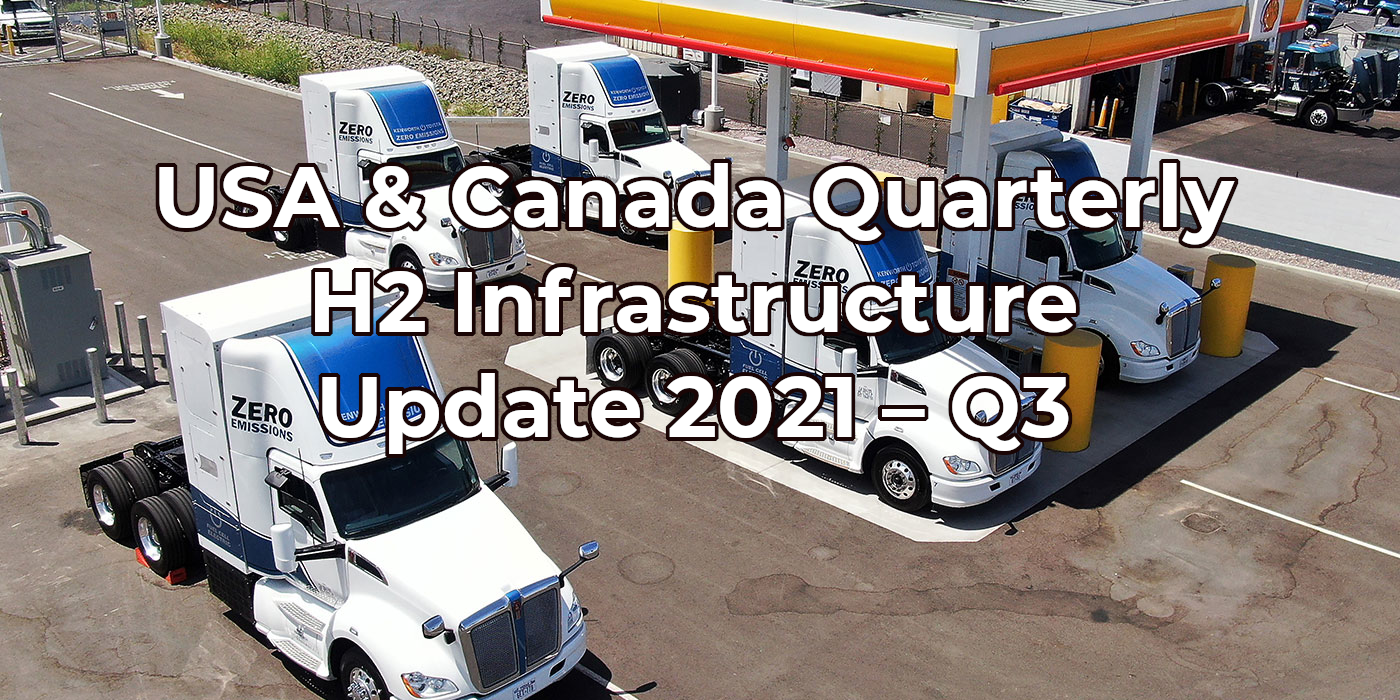Welcome new readers of RMP’s quarterly H2 infrastructure report. Each quarter we look back on the major stories related to hydrogen infrastructure advancements and we compare the current AFDC database to the AFDC database in the prior quarter to see what has changed. The AFDC database is updated by the US Dept of Energy & can be found by clicking here. RMP also keeps a supplemental data table of hydrogen production, liquefaction, rail and truck refueling stations. RMP adds our additional locations to the DOE’s database of Class 1 refueling locations to make a comprehensive map of all North American hydrogen infrastructure. You can view RMP’s interactive map of hydrogen infrastructure in the USA & Canada by clicking here. Ok, on with the report…
The two major stories of the quarter are those of both good news and bad news. Let’s start with the not so good news. California’s Gen2 liquid hydrogen refueling stations continue to have start up problems. These “big” stations still have the potential to be game changers for FCEV drivers in California but have not launched well in terms of uptime and availability. The main Gen2 stations I’m referring to are:
-
-
-
- First Element – Aliso Viejo
- First Element – Concord
- First Element – Campbell Hamilton
- First Element – Placentia
- First Element – Studio City
- First Element – Sunnyvale
- First Element – Mission Hills
- First Element – Fountain Valley
-
-
All Eight of the stations named above, according to RMP’s new real-time SOSS data tracker under development, have showed poor uptime and availability over the past quarter. This fact showing in the SOSS data is also corroborated by frustrated drivers on the Hydrogen Car Owners facebook group. Furthermore, these startup issues are exacerbated by short supply of liquid hydrogen which comes all the way from New Orleans. When Hurricane Ida made landfall in New Orleans at the end of August, liquid hydrogen production at Air Products New Orleans facility was stalled and disrupted shipments of LH2 to California drivers.
While it has been a tough quarter for early adopters of FCEVs like Toyota’s Mirai, it does lead to the good news: help is on the way. More LH2 (liquid hydrogen) production is on the way to help eliminate supply disruptions to California drivers. It’s important to note that the new production coming online soon and planned to come online over the next couple years is all 100% green hydrogen.
RMP added twelve new locations to our North American hydrogen infrastructure map this month that cannot be found on the DOE’s database. Of those twelve newly added locations, five are manufacturing locations where hydrogen fuel cell systems will be made and seven of them are planned hydrogen production locations. Three of the seven production locations are production only and four of the seven are production and liquefaction. Here’s the kicker of a statistic though: all seven new production locations are going to make 100% green hydrogen dispelling another myth about hydrogen.

The legacy hydrogen industry mostly serves the oil industry as hydrogen is used in the oil refining process. The majority percentage of the hydrogen used in the oil industry is made from reforming natural gas. The folks that like to talk bad about hydrogen like to say over 90% of hydrogen is currently made from fossil fuels. This misleading statement is about to go away very quickly because legacy hydrogen production has only ever been made for oil refining. All the new production coming online for hydrogen for vehicles is 100% green. When someone says over 90% of hydrogen produced today comes from fossil fuels, you can correct them and say “100% of production of hydrogen planned for fuel cell cars comes from zero emissions renewable energy”.
All of this new hydrogen gives BEV cars a chance to fast charge from 100% renewable energy. Right now there is not a single off-grid 100% renewable solar or wind fast charger in the world. Most BEV charging comes from natural gas & coal and super fast chargers located near coal & natural gas plants extend the long term use of burning fossil fuels. With an abundance of green hydrogen planned for the USA, fast chargers can be powered by fuel cells which will charge batteries with green and off-grid energy; this will be critically important during severe weather events that can impact fossil fuel grid electricity that BEVs currently depend on. With enough green hydrogen we can have both FCEVs and BEVs get 100% renewable energy. Without green hydrogen, super fast charging will continue to supplied with majority coal & natural gas to make those electrons. We need hydrogen to help make BEVs cleaner & help them avoid outage risks from severe weather events. BEVs are a lot cooler when they’re charged with green hydrogen.
The first big green hydrogen plant to come online to help support California FCEV drivers will be the Air Liquide North Las Vegas plant which is in strategic proximity to California. This production & liquefaction location currently under construction is expected to open in Q1 of 2022 and supply about 30 tons of LH2 per day or enough for about 40,000 FCEVs. Currently on California roads, there are about 10k FCEVs registered in California. This one production location should help the number of FCEVs grow four-fold in the coming years. As more and more green hydrogen production locations come online, the number of FCEVs can continue to grow at double digit and triple digit percentage rates for years to come.
Now let’s take a look at some of the top stories related to hydrogen infrastructure over the past quarter.
Hydrogen Highlights – Links To Top Stories 2021 Q3
7/6/2021 – B.C. Hydrogen Strategy published by the Government of British Columbia. The document is a blueprint for how renewable & low-carbon hydrogen will support its climate goals and create new jobs in B.C.’s growing clean-tech sector.
https://news.gov.bc.ca/releases/2021EMLI0045-001306
7/12/21 – North County Transit District filed a document with CEQA outlining a hydrogen refueling depot location for up to 50 Fuel Cell Electric Busses for public transportation in California.
https://ceqanet.opr.ca.gov/2021070179
7/23/2021 – AC Transit (Alameda / Contra Costa County) Transit (in Tesla’s backyard) released a study called the 5×5 study comparing five conventional diesel, five diesel hybrid, five electric FCEB, five BEB and five legacy FCEB, totaling 25 buses. The masstransitmag article makes it sound like the FCEB did much better in commercial service than its BEB counterpart. The study is also ongoing and this is the Mass Transit article that writes about here:
The actual study itself is here:
https://www.actransit.org/sites/default/files/2021-07/EDT-060420_Report-ZETBTA.pdf
8/14/2021 – Talks about SARTA’s 11 buses in Canton, Ohio and many other miscellaneous bits of info. Tells who made the buses: El Dorado and how many they started with (3 in 2016) and how many they have now (11).
https://www.nwaonline.com/news/2021/aug/14/transit-industry-tries-hydrogen-for-its-fuel/?business
8/11/21 – Tech Crunch posts this article with lots of good information but it also appears as though Aria Alamalhodaei @ TechCrunch is some kind of Elon shilly paid gun for hire type of writer. She has a very eccentric Twitter account but access to industry specific information as well as financial information, so it’s an interesting article.
8/10/21 – Fuel Cell Works published (as they always do) someone else’s press release. In this case, it was a Plug Power presser about the new green LH2 facility PP is building in Camden County Georgia. This story lists other Plug Power locations that need to be looked up and added to the map.
8/16/21 – California Energy Commission submitted a blueprint for the lowest cost Electric school bus fleet charging that will evaluate the benefits and costs of both BEB & FCEB zero emission technologies to get the appropriate mix of battery only & fuel cell + battery busses in a blended fleet of California school busses.
https://ceqanet.opr.ca.gov/2021080276
8/18/21 – Exelon Generation teams up with Nel Hydrogen to add an electrolyzer at their Nine Mile Point Nuclear Station in NY to make green hydrogen. The plant is rated at 3GW and has existing hydrogen infrastructure. The hydrogen manufacture is supposed to begin in 2022.
8/25/21 – Toyota announces via press release that they will be building Class 8 ready fuel cell powertrain systems that are “turn key” powertrains for heavy duty trucks. The Toyota Motor Manufacturing Kentucky (TMMK) plant will begin assembling integrated dual fuel cell (FC) modules destined for use in H2 powered heavy duty trucks. The system weighs 1,400lbs and can deliver 160kW of continuous power. The system also includes a high voltage battery, electric motors, transmission, and H2 storage system. Toyota will also offer powertrain integration consultation/experience. The system will be able to give 300 miles of range to full load weights of 80,000lbs.
https://pressroom.toyota.com/toyota-to-assemble-fuel-cell-modules-at-kentucky-plant-in-2023/
8/31/21 – Ballard announces collaboration with Hexagon Purus to produce Class 6 & 7 trucks with 400 miles of zero emission range. The trucks will first be deployed in California in the Los Angeles basin area. The first prototype truck is expected to be delivered in the 2nd Quarter of 2022.
8/27/21 – Hino Trucks debuts their Class 8 hydrogen fuel cell truck in Ann Arbor at Toyota’s North American R&D Headquarters. Hino Trucks new HQ is on 12 mile road in Farmington Hills about 15 minutes from RMP’s HQ right here in SE Michigan. This new class 8 truck is ready to haul freight in California right now and gives Toyota a big leg up on companies that are competing in the Class 8 #hydrogen space.
Watch this 6:10 YouTube video showcasing the truck:
https://www.youtube.com/watch?v=YyazZk2lCPA
9/10/2021 – Linde to construct $17.3M PEM electrolyser plant in Niagara Falls NY. Operational 2023. 100% green.
New H2 Stations Opened To The Public 2021 Q3:
No new hydrogen refueling stations opened to the public in Q3-2021. There are currently 3 stations commissioning: Sherman Oaks, Woodside, and San Jose. There are 8 stations under construction.
Fuel Cell Electric Vehicles Registered in North America 2021 Q3:
RMP uses data from IHS Markit Worldview to report FCEV registrations in the USA. IHS Markit is the industry standard source in the Detroit automotive industry for statistical registration data used in financial analysis & parts forecasting. IHS Markit data updates are published quarterly & lag approx two months behind calendar date for processing into the database. Therefore, in this quarter’s report, you’re looking at last quarter’s data which is the most recent and was published about one month behind this article’s publication date. Below are two tables compiled by RMP showing FCEVs registered in the USA by state and in California by county.
The table below shows a 15.4% quarter over quarter increase in the number of FCEVs registered in the USA with California primarily driving the number. That’s the biggest jump in a long time. The year over year increase in the last 12 months shows 30% growth. RMP expects growth of FCEV registrations in the USA to grow substantially in 2022 as the Las Vegas LH2 plant comes online & start up issues for the new Gen2 refueling stations get resolved.

Since California is the primary driver of FCEV registration statistics, RMP prepares a second table of FCEVs registered by county in California.

Final Remarks for 2021 Q3
Q3 is another quarter of stops and starts for hydrogen infrastructure. A busy quarter in terms of adding 12 more planned locations to RMP’s USA & Canada infrastructure map, but a disappointing quarter for the drivers of FCEVs who struggled to refuel with new station issues and hydrogen supply chain issues.
While it’s great to see so much planning for new production capacity, it’s frustrating to see such poor uptimes for these new Gen2 stations with such high hopes pinned to them. As issues get worked out and resolved, those same fixes should help other stations implement the lessons learned through these growing pains.
The Air Liquide plant in North Las Vegas will be a real milestone event as it should produce enough green LH2 to supply 40,000 FCEVs in California or 4x the current amount of cars registered in California. This should buy some time for other green hydrogen production facilities to come online and the uptake of hydrogen can start to scale up.
Just want to thank all the pioneers driving their FCEVs in California helping to pave the way toward sustainable transportation for all. It’s no easy task completely transforming our energy paradigms from dirty to clean, so thank you pioneers!
See you next quarter

Leave a Reply to Tadashi Ogitsu Cancel reply